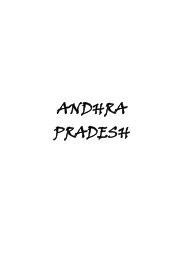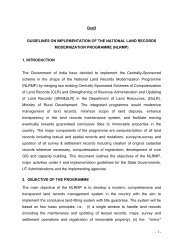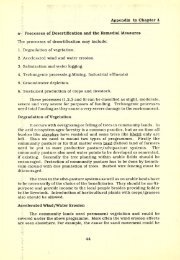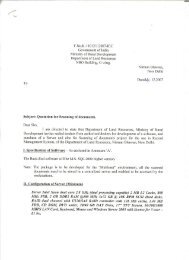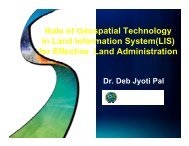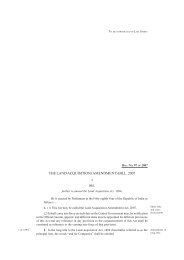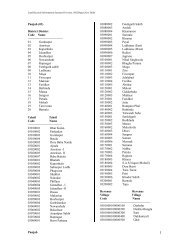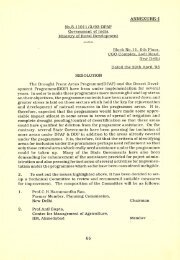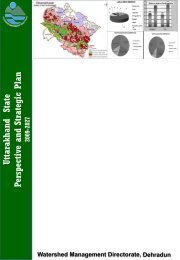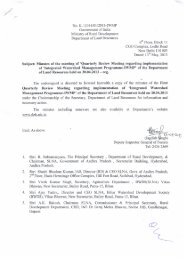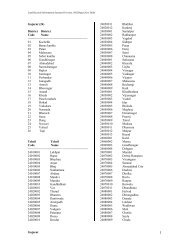Table 2 - Department of Land Resources
Table 2 - Department of Land Resources
Table 2 - Department of Land Resources
Create successful ePaper yourself
Turn your PDF publications into a flip-book with our unique Google optimized e-Paper software.
Entry <strong>of</strong> all the backlog mutations to make the villages online (as on date) so that<br />
it can be integrated with the deed registration system.<br />
Strategies adopted<br />
a) Process <strong>of</strong> Involvement <strong>of</strong> Stakeholders: Financial Commissioner Revenue<br />
constituted state level standardization & Monitoring Committee. NIC Haryana<br />
also constituted a dedicated team <strong>of</strong> pr<strong>of</strong>essionals for the project. The workshops<br />
were organized at Division Commissioner level, where all stakeholders were<br />
called and various re-engineered processes were discovered and discussed. At the<br />
field level also, detailed discussions were held at Patwari level, private deeds<br />
writers, Panchayats, retired revenue <strong>of</strong>ficials and at the level <strong>of</strong> District Revenue<br />
<strong>of</strong>ficers, Tehsildars, Kanoongos etc. Each type <strong>of</strong> cases <strong>of</strong> writing the Jamabandi<br />
and incorporating the mutations were studied and standardized across the state.<br />
b) Process Standardization and Simplification: (a) All applicable deed types were<br />
studied and standardized to design 22 types <strong>of</strong> deed registration Templates. These<br />
templates were converted into XML documents and made available to all HARIS<br />
implementation centres in the state. (b) All type <strong>of</strong> reported cases related to<br />
writing <strong>of</strong> Jamabandi (ROR) and Mutations were studied and standardized and<br />
simplified so as to handle under HALRIS uniformly across the state. The cases,<br />
which could not be simplified, were incorporated in HALRIS through suitable<br />
customization and enhancement <strong>of</strong> HALRIS. (c) HARIS & HALRIS were<br />
dynamically integrated in a workflow environment to facilitate generation <strong>of</strong><br />
mutations notices and entry <strong>of</strong> mutations after the deed registration.<br />
c) Operational Flow in Online Scenario: In case <strong>of</strong> online villages HARIS<br />
immediately post the remarks in col. 12 <strong>of</strong> the Jamabandi <strong>of</strong> the khewats<br />
transacted in the registry. This remark shows the name <strong>of</strong> the seller and date <strong>of</strong><br />
registry. This is done to alert the perspective buyer from the multiple times sale <strong>of</strong><br />
land. This fills the gap that exists between the deed registration and entry <strong>of</strong><br />
mutation in the manual system. As for every registry seller has to take a fresh<br />
nakal <strong>of</strong> ROR from the Tehsils Centre and after registration ROR <strong>of</strong> affected<br />
khewats clearly show that some transaction has already been initiated on this<br />
khewat. Documents after the signatures <strong>of</strong> sub registrar come to mutation window<br />
for mutation entry. Request for Mutation not generated from registration process<br />
like Inheritance etc directly come to mutation entry window. Patwari sitting at the<br />
window examine the papers and help the data entry operator for mutation entry.<br />
Registration remarks automatically disappear after mutation entry and Pencil<br />
remarks as written by Patwari in the manual process, come automatically. Print <strong>of</strong><br />
the mutations is given to the <strong>of</strong>fice kanungo for verification and he records his<br />
verification report in the mutation verification module. If verification report is ok<br />
mutation can go for attestation. CRO take the computer-generated hard copies <strong>of</strong><br />
mutation to Jalsa-ai-Aam. All mutations decided by the CRO come to the Tehsil<br />
centre. CRO uses the mutation-sanctioning module to sanction or reject the<br />
mutations. Remarks in the col. 12 change to Red for khewats <strong>of</strong> sanctioned<br />
NIC,Deity,MCIT,GOI DOLR,MORD,GOI 25




